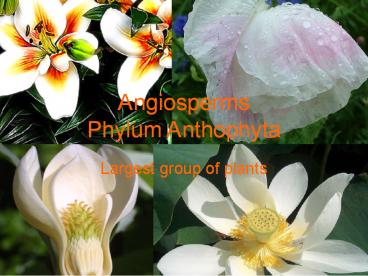Angiosperms Phylum Anthophyta PowerPoint PPT Presentation
Title: Angiosperms Phylum Anthophyta
1
AngiospermsPhylum Anthophyta
- Largest group of plants
2
Angiosperms are flowering plants.
- They have true roots, stems, leaves and
flowers... - Angiosperms are more highly evolved that the
algae, mosses, fungi and ferns. Their advanced
structures allow angiosperms to thrive on land.
3
Angiosperm
- Angeion vessel or carpal
- Sperma seed
- The carpal which contains the ovule that develop
into seeds after fertilization - The carpal itself develops into the fruit wall.
4
Angiosperms are the biggest group in the plant
kingdom.And very diverse!
5
Matt of Duckweed, smallest flowering plants
6
Angiosperm
- They have roots that hold the plant in place and
take in needed minerals and water. They have
leaves that are the major food makes for the
plant. They have stems that hold the plants up
and move the nutrients and water about the plant.
7
- They also have seeds.The seeds are formed when an
egg or ovule is fertilized by pollen in the
ovary. The ovary is within a flower. The flower
contains the male and/or female parts of the
plant. Fruits are frequently produced from these
ripened ovaries.
8
Stamens and a Style
Flowering duckweed plant
9
Angiosperm benefits
- Angiosperms the primary food source for animals-
grains, beans, nuts, fruits, vegetables, herbs
and spices almost all come from plants with
flowers, as do tea, coffee, chocolate, wine,
beer, tequila, and cola. - They provide lumber for buildings and other
objects, fibers for clothes, are the basis for
many drugs, etc - provides oxygen for us to breathe.
10
Compare to other seed plants
- Like other seed plants, angiosperms are
heterosporangiate-producing pollen and ovules in
different organs. - Unlike most seed plants, however, the pollen and
ovule-bearing organs are usually produced
together in a bisporangiate strobilus called a
flower.
11
The flower
- In the center of a typical flower are the
carpels, modified leaves which enclose the
ovules. These are often fused to form a single
pistil in the center of the flower. - Surrounding the carpels are several narrow stalks
topped by pollen sacs these pollen-bearing
stalks are called stamens. - Around these reproductive organs is the perianth,
usually consisting of an outer whorl of sepals
and an inner whorl of petals.
12
Flower parts
13
(No Transcript)
14
Collectively Sepals form the calyx Petals form
the corolla Both form perianth
15
Contains microsporangia
16
- In monocots and "primitive" dicots, the sepals
and petals may be indistinguishable, in this case
the perianth parts are called tepals.
17
Angiosperm
- Monophyletic
- Include two large classes
- Monocotyledones (monocots)
- Grasses, lilies, irises, orchids, cattails, and
palms - Eudicotyledones (eudicots)
- Almost all familiar trees, and shrubs other than
the conifers and many nonwoody plants (herbs).
18
Monocots Drupe
19
Flowers and fruit of the banana
20
Rice
21
Eudicots
- Saguaro cactus
- Thick fleshy stem store water
- Contain chloroplast
- Taken over photosynthetic function
- Round lobed hepatica
- Flower on deciduous woodlands
- No petals
- 6-10 sepals
- Numerous spirally arranged stamens and carpels
- California poppy
22
Saquaro catus (Carnegiea gigantea)
23
Round lobed hepatica (Anemone americana)
24
(No Transcript)
25
Most are free living but some are Parasitic
- Dodder (Cuscuta salina)
- Member of the morning glory family
- Rafflesia arnoldii
- Parasitic on the roots of a member of the grape
family
26
Dodder
27
Rafflesia arnoldii
28
Some Angiosperm are Saprophytic
Indian pipe (Monotropa uniflora)
29
Inflorescences
- In many angiosperms, the flowers are arranged in
clusters called inflorescences. - The flowers may be attached along a tall stalk,
arranged in broad open clusters, or pressed
tightly together so that the cluster looks like a
single flower.
30
(No Transcript)
31
Shooting Star
32
Butter and eggs
33
Lupine
34
bluebells
35
Water hemlock
36
Oak flowers
37
Position of ovary
38
Epigyny
39
(No Transcript)
40
Perigyny
41
(No Transcript)
42
(No Transcript)
43
Pollen grains
Emerging Pollen tube
44
Pollen grain of ragweed- hayfever
45
(No Transcript)
46
(No Transcript)
47
(No Transcript)
48
(No Transcript)
49
(No Transcript)
50
(No Transcript)
51
(No Transcript)
52
(No Transcript)
53
(No Transcript)
54
(No Transcript)
55
(No Transcript)

